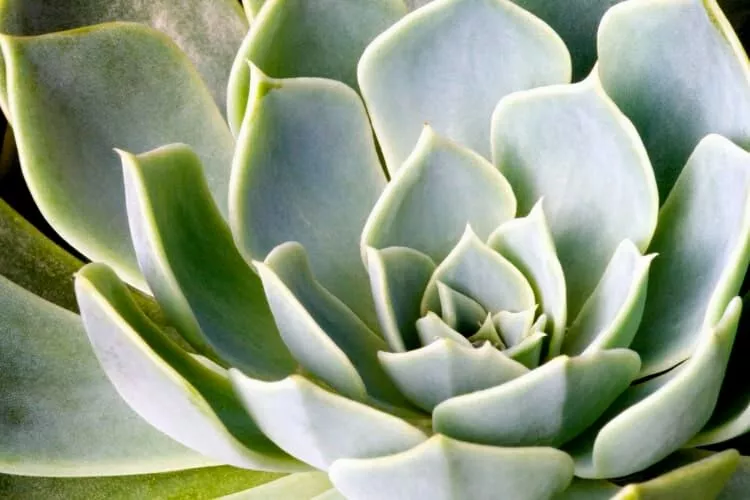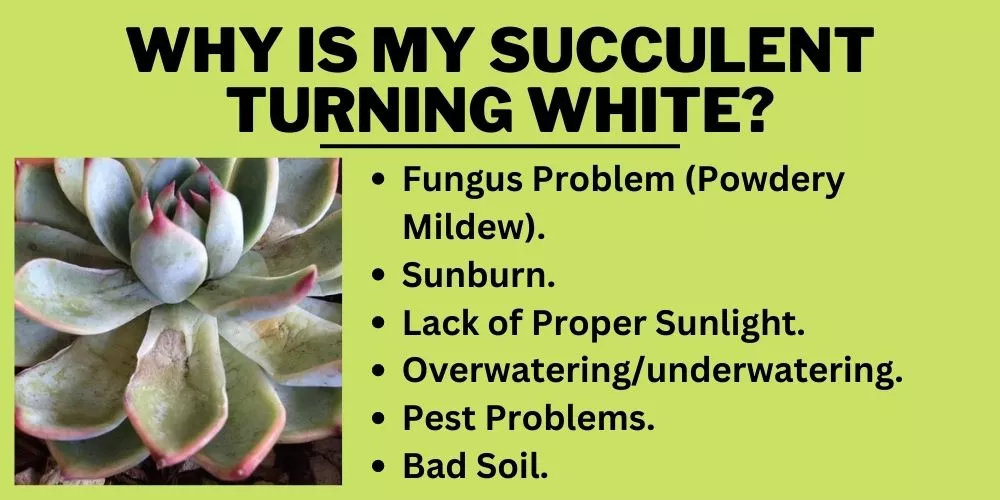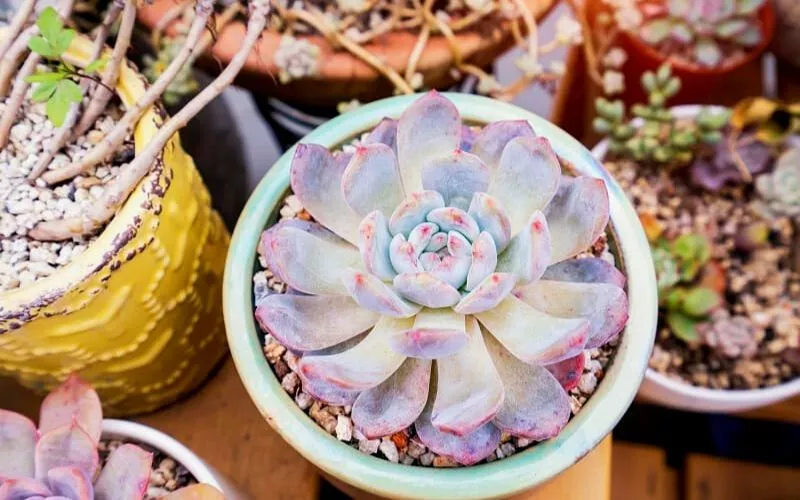Succulents are fast becoming the houseplant of choice for several growers, and for a good reason.
They are generally easy to grow and maintain. They are also quite affordable. One of the biggest problems that may arise when developing these beauties, is succulent turning white.
Any discoloration is a sign that one or multiple growing conditions for your succulent are out of balance. There are several reasons that this may occur. These include fungal issues, sunburn, inadequate sunlight, overwatering, pest infestation, and/or poor soil.

The key is to work out what it is and correct it before it is too late. In this article, we’ll go through the many reasons and what you can do to fix the issue. Let’s dive in, shall we?
Table of Contents
Why is my succulent turning white?
Succulents are usually pretty simple to maintain, but certain growing conditions that aren’t functioning can throw the balance off. Keep in mind that it is possible for 1 or even multiple of these conditions cannot work in harmony.

Here is the list of the most common reasons for succulent turning white. Let’s have a look at how to identify which one is causing the issue, as well as the process needed to correct it.
Fungus Problem (Powdery Mildew)
Powdery mildew is a fungal disease often mixed up with a process rather than a disease known as Farina. Farina is a reactive white, waxy coating formed by a succulent to help mitigate excess heat and sunburn.
Powdery mildew, on the other hand, causes more of a pale white to yellow color and can even make the stems form brown spots.
This fungal disease is often curable if discovered in its early stages. It won’t necessarily kill the plant but, more so, restrict them from taking in nutrients. Of course, a lack of nutrients can stunt their growth also.
Solution
Neem oil is probably your best bet to tackle a fungal disease of this nature. Aim to apply it later in the evening and give it at least 24 hours to fully effect.
You can also make your solution by adding 1 tablespoon of baking soda and ½ a tablespoon of liquid soap to 1 gallon of water. Give them a good mix and fill a spray bottle with the solution. Use it in the same way you would neem oil.
Sunburn
When a succulent is subject to excessive amounts of UV rays, it can start to turn white. It’s common to think that a sunburn-affected plant turns brown, but in the early stages of this condition is more of a white appearance.
When the plant starts to fade in color, it usually won’t revert to the vibrant colors that it once had. Over time, the affected leaves will eventually shed, and new ones will grow in their place.
Solution
The best way to deal with sunburnt plants is to mitigate the risk. It’s a good idea to grow your succulents somewhere that receives only 6 hours per day of direct sunlight.
If they are overexposed, you may want to consider adding some shade sail or covered roof to protect them.
Alternatively, if the succulents are potted, try to move them somewhere where they are protected from the sun’s rays.
Lack of Proper Sunlight
Interestingly, a succulent turning pale when receiving too much sun rays can also fade to white when inadequate light is available. Succulents need light to survive.
The early signs of lack of light are etiolation. This is when a plant uses all of its energy growing upwards or towards the light that stops producing foliage lower down. The stems become long and spindly as a result.
Solution
The easiest way to counteract this issue is to give them light by any means necessary. Move your plants somewhere different, for example, a window sill or outside if possible.
All they need is 6 hours of sunlight daily, and they will be satisfied. If these measures can’t be achieved, consider purchasing some grow lights so you can at least simulate the sun.
Overwatering/underwatering
Having an optimal balance of water is crucial to a succulent chance of survival. They don’t need too much water but require enough to allow them to store it for later use.
Overwatering a succulent combined with poorly draining soil can become a disaster. The roots will bathe in stagnant water and form root rot.
Early signs of root rot include pale white to yellow leaves. They can also go soft and mushy and almost see-through in the later stages.
On the other hand, underwatering a succulent will dry them out. The roots will wither and stop taking in nutrients to nourish the plant. As a result, the leaves will start to turn white/yellow.
Solution
Focus on your succulents, and observe them. Stick your finger into their growing medium (soil) and check to see if it’s completely dry.
If so, give it gentle water. Give it just enough so that the soil is moist but not flooded. It’s ideal to check the soil’s quality and ensure the water can drain properly.
Pest Problems
A few small pests can cause the problem of succulent turning white. A different characteristic can define each one. Mealybugs tend to leave the plant more white and fuzzy in appearance.
Scale bugs tend to leave white blotches or spots on the leaves and inside any small crevice of the plant. Spider mites spin their web and coat the plant with it.
All of these pests are also attracted to the leaves when the plant is overwatered, so they go in there and destroy the plant by eating them and then laying eggs there.
Another thing they all have in common because they diminish the plant’s nutrient stores, making it harder for it to recover from the damages caused.
The plant’s growth can also become stunted due to the lack of nutrients. In addition to the white appearance, the leaves can become damaged or dehydrated, and fungal diseases can form alongside mold.
Solution
Firstly, separate any affected plants from others you may have. You want to ensure they cannot spread and make things worse. Neem oil is one of the best solutions to remedy these issues.
It acts as both an insecticide and fungicide. Since pests can cause disease, neem oil can tackle both at once.
That can be sprayed on, coating the whole succulent. You can also use rubbing alcohol by dipping a cotton bud and dabbing the affected area until you are satisfied that all pests are gone.
Both of these remedies need a good 24 hours to take effect. Once the treatment is complete, go back over any remaining areas until you are satisfied that the plant is clean.
Bad Soil
Having the right soil composition is one of the most vital conditions to have control of when growing succulents. If the soil cannot drain and has any aeration, the roots will sit in water and bathe.
This will cause root rot as a result. In the early stages of rot, the plant leaves will turn pale white to yellow.

Solution
When planting your succulents, use a porous material such as sand to build the base, then mix in some drainage materials like coco coir, perlite, pumice, chicken grit, etc.
The sand will help bind the other ingredients while still allowing aeration, which assists the roots in establishing themselves.
The larger materials let water flow freely from the top of the plant past the roots and through the drainage holes. If you’re finding that your succulent leaves are beginning to discolor, act fast and report it while you still have the chance.
Frequently Asked Questions (fAQs)
What does an overwatered succulent look like?
When a succulent is overwatered, the earliest signs are soft, mushy, almost see-through looking leaves. They can also look frail and shriveled. Almost like when you spend too much time in the bath and your fingers are all wrinkly.
How do you tell a succulent is dying?
Several signs can indicate the cause. Darker, mushy leaves can indicate root rot. Palish, yellow leaves can show that an infection has taken over. The plant can be dehydrated if the leaves are wrinkled and wilted or start to shrivel up.
If you notice that the roots are darkening, that can signify some kind of infection or rot down there. All of these signs show that a succulent is almost unsavable.
Why is my succulent white and fuzzy?
A white and fuzzy appearance on a succulent plant means it would have mealybugs issues. This cottony substance is usually found around newer growth areas of the plant. They usually hide on the stem, the stem end of the leaves, and even inside the rosettes.
Why do succulents get Chalky?
That chalky substance is most likely powdery mildew. It is a fungal disease. It starts as smaller white spots on the leaves, then spreads to the rest of the plant if left unattended.
How do I know if my succulent has root rot?
If you notice your succulent forming limp, shriveled, and yellow leaves, they are early signs of rotting roots. The best way to check is by removing the plant from the pot and checking the condition of the roots. Dark brown to black colored, slimy roots are a sure sign of root rot.
Can you bring a succulent back to life?
This will depend on how far gone the plant is. If it is completely dead, it is impossible to revive. But, many growers don’t realize that their plant has the tiniest bit of life still kicking inside it. The best way to know is to remove it from its place of growth and gently clean it up, including removing any dead limbs. Air dries the whole plant and allows the limbs to be insensitive. Replant with new nutrients, soil, and water. Give it 2-3 days to see if any new growth forms; if so, it will survive!
Conclusion
As we have discovered, many factors can occur the issue of succulent turning white. These include fungal diseases, sunburn, inadequate sunlight, water balancing, pest issues, and proper soil.
The whole plant can suffer if even one of these problems is out of balance.
The best thing you can do is observe your plants and treat them as another life. Watch for the signs and adjust accordingly.
We hope this article has been helpful, and we look forward to helping you grow your garden knowledge along this journey.


